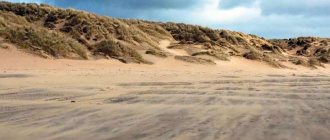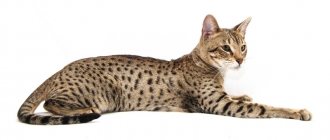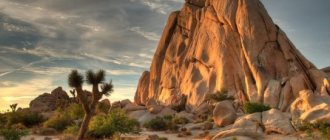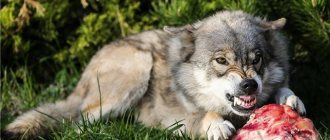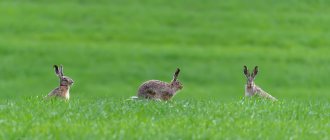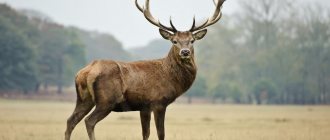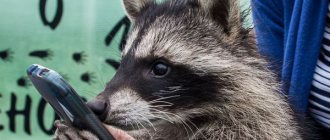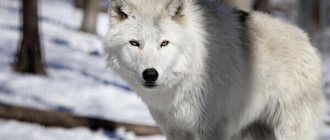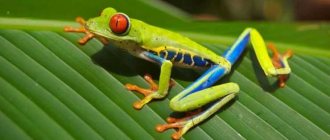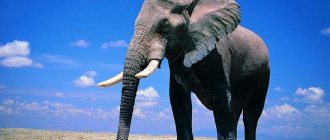What are savannas
Savannas are vast areas that occupy a significant part of the subequatorial belt, covered with tall grassy vegetation and rare trees.
From the description of the natural zone of savannas and woodlands, the main points should be noted:
- The grass cover is higher than in the steppes, and it is based on hard-leaved grasses.
- Vegetation density can be high or low, so that the soil is visible.
- There may be no trees at all, but there are areas that are almost sparse forest.
Flora
Savannas and woodlands, despite the not very favorable climate, are inhabited by different species of animals and birds. Among them you can find:
- elephants;
- Lviv;
- zebras;
- giraffes;
- armadillos;
- antelope;
- rhinoceroses;
- ostriches;
- marabou.
All these animals and birds have adapted to the arid climate. But even they have to migrate to other areas when there is no water left in the savannah.
For many years, humanity exterminated these animals. Now there are fewer and fewer of them. For most animal species, reserves have been created to preserve them in nature.
Rice. 2. Savanna fauna
Geographical position
Location - subequatorial belt in both the northern and southern hemispheres. The map of natural zones shows that grassy areas cover almost 40% of the area of Africa, and certain territories are also located in Australia, North-East Asia, and America.
In South America, the natural zone covers the Brazilian Highlands and the plains of the Orinoco River. In Brazil, areas are occupied predominantly by open forest; in the Orinoco basin there is almost no woody vegetation. South American savannas have different names: Brazilian - campos, Venezuelan - llanos.
In Asia, the natural zone occupies certain parts of India, Burma, Ceylon, and Indochina.
In Australia, grassy areas are located in the northeast and are characterized by a pronounced dry period.
Savanna plants
The flora is represented by a high grass cover with isolated trees and shrubs, and small groups of trees.
Most plants are hydrophytes, but there are also xerophytes adapted to the dry season. During the dry months, cereals burn out and many trees lose their leaves. Grasses stretch up to 3 m, and in the lowlands up to 5 m.
Characteristic plant species:
- elephant grass;
- oil palm;
- doom palm;
- pandanus;
- baobab is a thick tree with an unusually shaped trunk.
In wetter places, the grass cover becomes lower (up to 1.5 m), supplemented by acacias - trees with a dense spreading crown, reminiscent of an umbrella.
Drier areas are characterized by thorny semi-savannas. The trees are without leaves almost all year round, the grass carpet is sparse and low (up to 1 m).
The flora is represented by low prickly tree species, succulents, and cushion shrubs. Some scientists call these areas the African steppe.
Vegetable world
Savannah vegetation has successfully adapted to a changing climate. With the onset of drought, plants dry out. It is noteworthy that most grasses and shrubs have heavily overgrown roots that do not allow the plants to dry out completely. Fires often occur at this time of year, so many tree trunks can be seen scorched. During the rainy season, nature awakens and delights the eye with a riot of colors.
Description of several savanna plants:
- Baobab can grow for about 1 thousand years. It is impossible to determine its age in the usual way, since the plant does not have growth rings. It is interesting to watch the baobab blossom. It lasts for several months, but each flower lives only one night, and during the day the flowers are not visible.
- Elephant grass reaches a height of 3 meters. It grows near small bodies of water. When there is not enough water, the grass simply falls to the ground. And a slight cold snap leads to the death of ground stems. Giraffes, zebras and other herbivores eat grass.
- Dracaena grows slowly and for a long time with a single trunk. And after flowering, the crown takes the shape of an umbrella. The leaves on the tree grow very densely, so the plant casts a beautiful shadow. The tree produces red sap, which is used in cosmetology, paint production and medicine.
- Acacia Senegalese is a tree with a thin trunk. Acacia sap, when dried, turns into a hard transparent resin. The substance is extracted and used in cosmetology, industry, and medicine. Many animals love to feast on the leaves and pods of the tree.
- Mongongo is a tree that prefers dry climates. Able to accumulate moisture in a trunk with thick bark. It grows mainly in the southern savannah of Africa. Many Africans eat tree nuts every day.
Savannah is an amazing natural area full of secrets. A person who visits the savannah will be able to get acquainted with the rich flora and fauna and appreciate the beauty of a safari.
Soils
The main ones are red-brown and lateritic soils, characterized by sufficient humus content due to the abundant decomposition of grass.
Due to periodic moisture in the soil layers, saturation with metal oxides occurs actively, so crusts often appear on the surface of the earth.
Seasonality of moisture affects the processes of soil formation. In the wet season, soil layers are intensively leached; in the dry season, soil solutions rise due to heating of the earth's surface. Therefore, the accumulation of humus, blackening of soils, and the formation of chernozems are typical for dry savannas, where the period without precipitation is long.
What animals live in the taiga?
The fauna of the taiga is richer and more diverse than the tundra, but poorer than the fauna of deciduous and mixed forests. Lynx, wolverine, wolf, fox, brown bear, otter, sable, weasel, ermine, etc. are widespread; Hares, shrews, and rodents are numerous: beavers, chipmunks, mice, voles, squirrels and flying squirrels.
Interesting materials:
How to make a stone in Minecraft? How to make a rainbow sheep in Minecraft? How to make a vertical video in Movavi? How to make a mail ru home page in Mozilla? How to make an audio recording on a laptop? How to do a rollback in Nvidia Experience? How to take several VK photos in one story? How can I make emails arrive in a specific folder in Outlook 2016? How to make a request in Outlook? How to make a Padding in Outlook?
Climate and climate zones
Savannas are located in the subequatorial climate zone. Two seasons are clearly identified: dry winter and wet summer. The annual temperature ranges from 18 to 32°C. Temperature fluctuations are slow and unexpressed.
The dry cool period lasts from November to April. The average temperature is 21°C. The weather is sunny, fires are frequent. No more than 4 inches (100 mm) of precipitation falls.
The dry season is the time of migration. Huge herds of ungulates go in search of food and water, and predators rush after them. Woody species survive in dry times thanks to their deep root system and dense, fire-resistant bark.
The hot, humid period begins in May and lasts until October. The amount of precipitation during the period reaches 10 - 30 inches (250 - 750 mm). Heavy rain falls in the afternoon.
During the rainy season, the life of the savannah is in full swing, the land is reborn after drought, covered with a lush green carpet.
Predators
There are many predators in the African savannas. Among them, the first place undoubtedly belongs to the lion. Lions usually live in groups - prides, which include both adult males and females, and growing youth. Responsibilities between the members of the pride are distributed very clearly: the lighter and more agile lionesses provide the pride with food, and the larger and stronger males are responsible for protecting the territory. The prey of lions includes zebras, wildebeest, and kongoni, but on occasion, lions willingly eat smaller animals and even carrion.
The relationship between lions and another predatory animal of the African savanna – the spotted hyena – is very interesting. It was believed that the hyena feeds mainly on the leftovers from lions' meals, that it is cowardly, inactive and almost does not hunt on its own. Research in recent years has shown that this is not the case. It turned out that hyenas hunt at night (which is why they knew nothing about hyena hunting), that they easily kill even such large prey as wildebeest and zebra, and that it is not hyenas that “parasitize” lions, but lions on hyenas! Hearing the voices of the hyenas who have taken possession of the prey, the lions immediately rush there and drive away the hyenas. It happens that hyenas do not retreat and force the lion to leave. Experiments have shown that lions can be easily lured by playing a tape recording of a hyena roll call. By the way, only recently has it become reliably known that hyenas often attack people and are very dangerous.
Other predators of the savannah include the leopard and cheetah. These large cats, somewhat similar in appearance but completely different in lifestyle, have now become quite rare. The cheetah's main prey is gazelles, while the leopard is a more versatile hunter: in addition to small antelopes, it successfully hunts African wild pigs - warthogs and especially baboons. When almost all leopards were exterminated in Africa, baboons and warthogs multiplied and became a real disaster for crops. The leopards had to be taken under protection.
Savannah inhabitants
The savannah fauna is unique. Nowhere else on the planet is there such a diversity of large ungulates and predators.
Unfortunately, since the beginning of the 20th century, wildlife has been seriously suffering due to the activities of poachers and indefatigable hunters, the construction of roads, and the allocation of large areas for cattle breeding and agriculture.
The list of animals that have disappeared due to hunting includes:
- white-tailed wildebeest;
- horse antelope;
- zebra quagga.
Ungulates
The largest group of savanna ungulates lives in Africa.
The most common:
- blue wildebeest;
- zebras;
- Thompson's gazelles;
- Grant's gazelles;
- impalas;
- Cannes;
- cow antelope;
- swamp;
- giraffes;
- buffalos;
- warthogs;
- African elephants.
Rare ungulates found only in nature reserves are kudu and oryx.
Black and white rhinoceroses are on the verge of extinction. Their luxurious horn, as seen in the photo, is a valuable catch for poachers.
Great efforts are made in the reserves to preserve these animals.
Predators
Carnivorous animals are as diverse as herbivores.
Common on the African plains:
- lions;
- spotted hyenas;
- wild dogs;
- leopards;
- cheetahs;
- caracals;
- Nile crocodiles.
The American steppes are inhabited by:
- jaguars;
- ocelots;
- maned wolves;
- cougars.
In Australia:
- monitor lizards;
- Dingo dogs.
Birds
The diversity of African birds is amazing and attracts tourists from all over the world.
Can see:
- African ostrich (the largest modern bird);
- weavers;
- guinea fowl;
- bee-eaters;
- roller;
- secretary bird;
- horned crows;
- lapwings;
- larks;
- buffoon eagle;
- starlings;
- Voloklyuy (sitting on the backs of large ungulates and pecking parasitic insects from their skins).
In the trees, birds coexist with baboons and numerous species of monkeys. Flamingos decorate the ponds.
Rhea ostriches are inhabitants of the Brazilian steppes, emus ostriches are inhabitants of Australian ones.
Birds
It is not possible to talk about all the birds that are found in savannas on different continents in one article. Let's mention three unique birds:
- African ostrich
- African Great Bustard
- African long-eared vulture
The fact is that these are the largest birds of their kind. The ostrich is generally the largest bird on earth. True, he doesn't fly. But he runs very fast. With a height of up to 2.7 meters and a weight of up to 155 kg, the ostrich can reach speeds of up to 70 km per hour! The bird's step when running is 3-4 meters.
Ostrich
The African bustard is also a phenomenon of its own - it is the largest flying bird on our planet. It is larger than the common bustard; there are males up to 1.2 meters weighing 20 kg.
African Great Bustard
As for the long-eared vulture, if it is not the largest of the vultures, it is certainly one of the three largest. Only the Himalayan and Cape vultures can compete with it in size. In a diving flight, the African long-eared vulture reaches a speed of 120 km per hour.
African long-eared vulture

